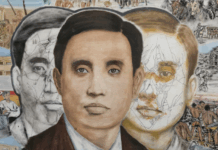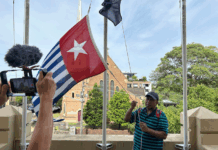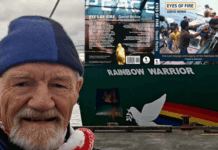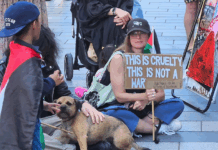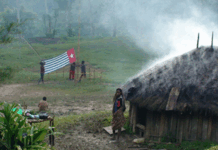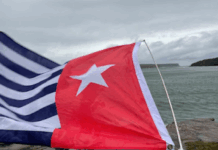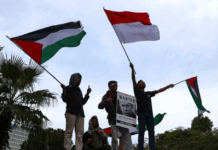
In the West Bank, one in three Palestinians has experienced one or more incarcerations during their life since 1967, or 35 percent of the population, while in Kanaky, the Nouméa prison, known as Camp Est, is populated by 95 percent Kanaks, while they represent only 39 to 43 percent of the Caledonian population.
SPECIAL REPORT: Samidoun
On Friday, July 5, France announced the continued provisional detention on mainland France of 5 Kanak defendants, out of seven pro-independence “leaders” who had been deported from Kanaky New Caledonia on June 23.
The subsequent announcements of the arrest of 11 pro-independence activists, including 9 provisional detentions (including Joël Tjibaou and Gilles Jorédié, incarcerated in Camp Est) and 7 incarcerations in mainland France (Christian Tein, Frédérique Muliava, Brenda Wanabo-Ipeze, Dimitri Tein Qenegei, Guillaume Vama, Steve Unë and Yewa Waethane), more than 17,000 kilometres from their homeland, revived the mobilisations that had begun a month earlier as part of the fight against the plan to “unfreeze” the Kanaky electoral body.
Suspended after President Emmanuel Macron announced the dissolution of the National Assembly, this project actually aims to reverse the achievements of the Nouméa Accords signed in 1998.
- READ MORE: PIF hopes to send delegation to New Caledonia, says Forum chair
- Other Kanaky New Caledonia crisis reports
It is part of the strategy of strengthening French colonialism in Kanaky by extending the ability to vote on local matters, including independence referandums, to an even greater number of settlers, making the indigenous Kanaks a de facto minority at the ballot box.
On July 11, 10 Centaur armoured vehicles, 15 fire trucks, a dozen all-terrain military armoured vehicles and numerous army trucks were landed by ship in Kanaky, where the population remains under curfew.
This entire sequence bears witness to the manner in which France, through its colonial administration, deploys a repressive security arsenal that on the one hand protects the settlers on the land and their reactionary militias, and on the other, attempts to destroy the country’s Kanak independence movement.
Imprisonment and incarceration are a weapon of choice in this overall colonial strategy.
Imprisonment is one of the key weapons of choice in colonial strategies to try to stifle independence and national liberation struggles, from the Zionist regime in Palestine to allied imperialist countries and colonial empires such as France.
While the figures are incomparable due to differences between the populations and conditions, in the West Bank, according to Stéphanie Latte Abdallah, one in three Palestinians has experienced one or more incarcerations during their life since 1967, or 35 percent of the population, while in Kanaky, the Nouméa prison, known as Camp Est, is populated by 95 percent Kanaks, while they represent only 39 to 43 percent of the Caledonian population.

Nicknamed “the island of oblivion” by the prisoners, the Camp Est prison locks up many young Kanaks excluded from the economic, educational and health systems, and symbolises the French colonial continuum, especially as the building partly occupies the space of the former French penal colony imposed there.
Silence of sociologists
Few studies exist of this over-incarceration of the Kanak population, and as Hamid Mokadem reminds us:
“The silence of sociologists and demographers on ethno-cultural inequalities is inversely proportional to the chatter of anthropologists on Kanak customs and culture.”
The incarceration rate is significantly higher than in mainland France, so much so that a new prison has been built.
The Koné detention center, and a project to replace Camp Est was announced in February 2024 by the Minister of Justice. He promised a 600-bed facility (compared to the 230 cells available at Camp Est) that would emerge after a construction project estimated at 500 million euros (NZ$908 million).
This is the largest investment by the French state on Kanak soil, a deadly promise that at the same time reaffirms France’s imperialist project in the Pacific, driven by its financial and geopolitical interests to retain its colonial properties there.
While waiting for this large-scale prison project, new cells have been fitted out in containers on which a double mesh roof has been installed, many without windows, and where the conditions of incarceration are even harsher than in the other sections of the prison, including those for men, women and minors, pre-trial detainees and those who have been convicted and sentenced.
The over-representation of the Kanak population has only increased, since incarceration has been one of the mechanisms through which the French government attempts to stem the movement against the plan to “unfreeze” and expand the electoral body, with 1139 arrests since mid-May.
The penalty of deportation
Local detention was supplemented by another penalty directly inherited from the Code de l’Indigénat: the penalty of deportation.
On June 23, after the announcement of the arrest of 7 Kanak independence activists in metropolitan France, the population learned that they were going to be deported 17,000 km from their homes.
A plane was waiting to transfer them to metropolitan France during their pretrial detention, all seven of them dispersed across the prisons of Dijon, Mulhouse, Bourges, Blois, Nevers, Villefranche and Riom.
This deportation of activists in the context of pre-trial detention directly recalls the events of 1988, and more broadly the way in which prison and removal were used in a colonial context.
From the 19th century and the deportation of Toussaint Louverture of Haiti to France, thousands of Algerians arrested during the uprisings against the French colonisation of Algeria at the same time as the detention of the prisoners of the Paris Commune in 1871, the Vietnamese of Hanoi in 1913, were deported to Kanaky or other colonies such as Guyana.
More recently, the Algerian revolutionaries, were massively incarcerated in metropolitan colonial prisons. From a principle inherited from the indigénat, and although today we have moved from an administrative decision to a judicial decision, the practice of deportation remains the same.
Particularly used in the context of anti-colonial resistance movements, the deportation of Kanak prisoners to metropolitan colonial prisons has been used on this scale since 1988 in Kanaky.
Ouvéa cave massacre
After the massacre of 19 Kanak independence fighters who had taken police officers prisoner in the Ouvéa cave, activists still alive were imprisoned, then deported, then released as part of the Matignon-Oudinot Accords.
Twenty six Kanak prisoners came to populate the prisons of the Paris region while they were still in preventive detention — while awaiting their trials and therefore presumed innocent, as is the case today for the CCAT activists currently incarcerated.
In the 1980s, French prisons were shaken by major revolts, particularly against the racism of the guards, who were mostly affiliated with the then-nascent Front National (FN), and more broadly against the penal policy of the Mitterrand left and the massively expanding length of sentences imposed at the time.
In 1988, as former prisoners wrote afterwards, some made a point of showing their solidarity with the Kanaks by sharing their clothes and food with them.
Because many of the activists were transferred in T-shirts, shorts and flip-flops, in trying conditions, with their hands cuffed during the 24-hour journey, underhand repression techniques of the Prison Administration that are still in force.
Similar deportation conditions were described by Christian Téin, spokesperson for the CCAT incarcerated in the isolation wing of the Mulhouse-Lutterbach Penitentiary Center. The shock of incarceration is all the more violent.
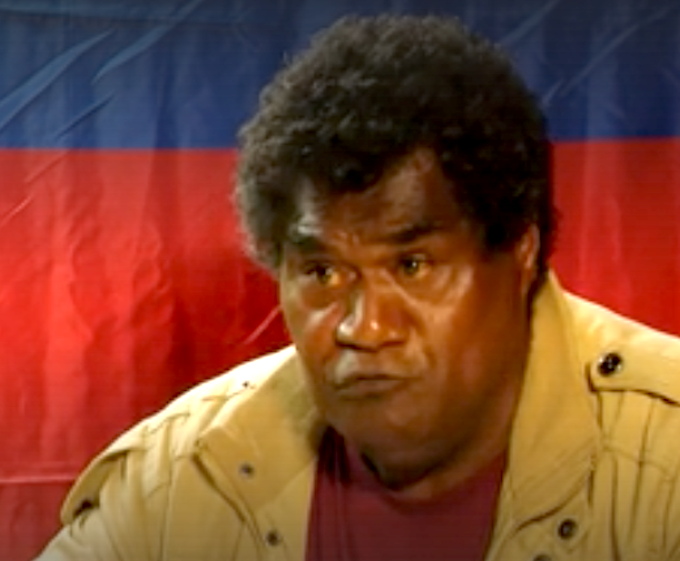
Added to this is the pain of the forced separation of parents and children, which is found not only in the current situation in metropolitan France but also in Palestine. Also there is great difficulty in finding loved ones, in attempting to find out which prisons they are in, or even if they are currently detained, continually encountering administrative violence, with the absence of information and the cruelty of official figures.
Orchestrated psychological impact
All this is orchestrated so that the psychological impact, in the long term, aims to induce the prisoners and also their families to stop fighting.
At the time of the events in Ouvéa, the uprooting of independence activists from their lands to lock them up in mainland France was commonplace, and the Kanak detainees joined those from the Caribbean Revolutionary Alliance such as Luc Reinette and Georges Faisans, incarcerated in Île-de-France during the 1980s alongside Corsican and Basque prisoners.
Since then, this had only happened once, in the context of the uprisings in Guadeloup in 2021, where several local figures, mostly community activists, had been deported and then incarcerated in mainland France and Martinique in an attempt to stifle the revolts in which a large number of Guadeloupean youth were mobilised.
Here again, we could draw a parallel with Palestine. As Assia Zaino points out, since the 2000s, the incarceration of Palestinians has systematically been synonymous with being torn away from their families and loved ones.
Zionist prisons, located within the Palestinian territories colonised in 1948, “are integrated into the civil prison system [. . . ] and entry bans on Israeli soil are frequently imposed on the families of detainees for security reasons,” which in fact aims to attack the relatives of detainees and destabilise the national liberation struggle.

From prison, the struggle continues
This mass incarceration is confronted by the powerful presence of prisoners as symbols of courage and resistance.
We know that in Palestine, as during the Algerian war of national liberation, incarceration is an opportunity to learn from one’s people, to forge national revolutionary consciousness but also to continue the struggle, very concretely, by mobilising against incarceration.
Because the Palestinian prisoners’ movement has transformed the colonial prison into a school of revolution: each political party has a prison branch whose political bureau or leadership is made up of imprisoned leaders.
These branches have real weight in the decisions taken outside the walls, and they are the ones responsible for leading the struggle in the colonial prisons, in particular by declaring collective hunger strikes and developing alliances of struggle that can mobilise several thousand prisoners, but also for organising the daily life of revolutionaries in prison.
It was this movement of prisoners that played a major role in driving the Palestinian resistance groups to unite under a unified command with the total liberation of historic Palestine as their compass, and to overcome internal contradictions.
Historically, the prisoners also constituted a significant part the most radical elements of the Palestinian revolution, notably by massively refusing any negotiation with the Zionist state at the time when the disastrous Oslo Accords were being prepared.
Resistance in colonial prisons can also take cultural forms, as illustrated by the very rich Palestinian prison literature, composed of literary works written in secret and smuggled out by prisoners to bear witness to the outside world of the vitality of their ideals, their struggle and the conditions of detention.
Courage of the children
An example is Walid Daqqah, a renowned writer and one of the longest-held Palestinian prisoners, who was martyred on 7 April 2024 during his 38th year of detention in colonial prisons.
In short, from the children and adolescents who wear courageous smiles as they leave their trials surrounded by soldiers, to the women of Damon prison who heroically stand up to their jailers, to the resistance of the prisoners who fight by putting their lives and health at risk while having a central role in the Resistance outside, it is the daily struggle of the prisoners’ movement that makes detention a place where resistance to the colonial regime is organised, continuing even inside detention.
As Charlotte Kates, Samidoun’s international coordinator, said:
“Despite the intention to use political imprisonment to suppress Palestinian resistance and derail the Palestinian liberation movement, Palestinian prisoners have remained political leaders and symbols of steadfastness for the struggle as a whole.”
In Kanaky, it was the announcement of the incarceration of CCAT activists on June 23 that relaunched the movement, who became the driving forces behind this new round of mobilisation.
On May 13, while the population was setting up roadblocks on the main roads of Nouméa, a mutiny broke out in the Camp Est prison in reaction to the plan to unfreeze the electoral body.
The prison was therefore directly part of the mobilisation, and three guards were taken hostage on this first day of struggle. They were quickly released after the RAID (French national police tactical unit) intervened.
But during the night of May 14-15, another revolt took place in the prison, rendering no fewer than 80 cells unusable.
It is therefore in this context of uprising and intifada throughout Kanaky, both in prisons and outside, that the announcement of the deportation of the 7 Kanak leaders took place.
In addition to these highly publicised deportations, there were also dozens of similar cases of transfers from Camp Est.
Completely ignored by the government, these took place both before May 23 and during the month of July, including participants in the prison uprisings as well as long-term prisoners transferred to relieve congestion in the Kanak prison.
Silence which masks the scale of these colonial deportations only intends to make the task of the families and political supporters of the Kanaks even more difficult in their attempt to show solidarity with the prisoners.
Furthermore, upon their arrival in mainland France, the CCAT activists were separated into 7 different prisons, directly recalling the policy of dispersion already at work in Spain at the end of the 1980s against ETA prisoners, in reaction to the effectiveness of their prison organising.
Today as yesterday, the colonial power dispatches prisoners throughout the mainland to prevent a collective counter-offensive. The prisoners’ connections with one another, but also with the outside, are consequently largely hampered.
This isolation directly aims to break the movement by tearing off its “head” and preventing any form of common struggle against this confinement. We therefore know that the momentum of struggle outside seems to respond to a hardening of detention conditions inside prisons, as evidenced by the isolation in which the CCAT activists are kept.
Likewise in Palestine, where since last October 7, mass arrests have escalated to the development of military concentration camps characterised by inhumane conditions of incarceration where severe torture is a daily, routine occurrence.
Currently, both for the more than 9300 Palestinian prisoners detained in the 19 Zionist colonial prisons, and for the thousands of prisoners from Gaza arrested during the genocidal offensive of the occupying forces on the Strip incarcerated in military camps, the conditions of detention have deteriorated significantly.
If in the colonial prisons Palestinian prisoners suffer hunger, collective isolation, overcrowding, violence and physical and psychological torture, conditions which have led to the martyrdom of at least 18 prisoners since October 7, in the military detention camps the situation is even more extreme.
The thousands of prisoners from Gaza held there are handcuffed and blindfolded 24 hours a day, forced to kneel on the ground, motionless for most of the day, raped and sexually assaulted and tortured daily, which leaves the released prisoners with enormous trauma.
Sick prisoners are crammed in naked, equipped with diapers, on beds without mattresses or blankets, in military airplane hangars and warehouses and without any medical care.
In all cases, isolation reigns, in prisons as in military detention centers, and the Zionist regime aims to cut off the Palestinian prisoners — and their collective movement — from the outside world.

Stories of prison escapes
Beyond the heroic prison uprisings, many stories of escapes from colonial prisons also fuel resistance and demonstrate the resilience of prisoners.
In Palestine, to cite a recent example, we recall the “Freedom Tunnel” operation, where six Palestinian prisoners freed themselves from the Zionist-occupied Gilboa high-security prison by digging a tunnel using a spoon.
The six Palestinians — Mahmoud al-Ardah, Mohammed al-Ardah, Yaqoub Qadri, Ayham Kamamji, Munadil Nafa’at and Zakaria Zubaidi — became Palestinian, Arab and international symbols of Palestinian resistance and the will for freedom.
While they were all rearrested, their escape exposed the weaknesses under the colonial myth of “impenetrable Israeli security”, plunging the occupation’s prison system into an internal crisis.
In France, the CRAs (Administrative Detention Centres) represent an ultra-violent manifestation of racism and the management of exiles. People are locked up in terrible and therefore deadly conditions.
Thus, faced with colonial management of populations, particularly from former French colonies, resistance is being organised.
For example, on the night of Friday, June 21 to Saturday, June 22, 14 people held at the CRA in Vincennes managed to escape (only one person has been re-arrested since).
This follows the escape of 11 detainees in December from this same place of confinement. However, these detention centres are often recent and very well equipped.
From Palestine to the Hegaxone and the colonial prisons in Kanaky, the resistance fighters fight day by day within the prison system itself, and the escapes and uprisings in the prisons are events that weaken the colonial propaganda and its myth of invincibility and total superiority.

Resistance continues
Despite the tightening of detention conditions and the security arsenal that is deployed against liberation movements, it is clear that the resistance is not stopping and that, on the contrary, organizing is becoming even more vigorous.
In Kanaky, new blockades in solidarity with the prisoners have spread well beyond Nouméa since June 23, demanding their immediate release and repatriation to Kanaky, since “touching one of them is touching everyone”.
In mainland France, numerous gatherings have also taken place since Monday at the call of the MKF (Kanak Movement in France), and among others led by the Collectif Solidarité Kanaky in front of the Ministry of Justice in Paris, and also in front of the prisons where the activists are still incarcerated.
Their prison numbers have been made public so that it is possible to write to them and so that broad and massive support can be communicated to them in order to provide them with the strength necessary for this fight from metropolitan France.
From now on, tributes to the Kanak martyrs who fell under the bullets of the colonial militias and the French State are joined by banners for the freedom of the prisoners.
Marah Bakir, a representative of Palestinian women prisoners, arrested at the age of 15 by the colonial army and imprisoned for 8 years, made these comments during her first interview given upon her release on 24 November 2023:
“It is very difficult to feel freedom and to be liberated in exchange for the blood of the martyrs of Gaza and the great sacrifices of our people in the Gaza Strip.”
The Kanaky ‘martyrs’:
Stéphanie Nassaie Doouka, 17, and Chrétien Neregote, 36, shot in the head on May 20 by a business manager.
Djibril Saïko Salo, 19, shot in the back on May 15 by loyalist settlers at a roadblock.
Dany Tidjite, 48, killed by an off-duty police officer who tried to impose a roadblock.
Joseph Poulawa, 34, killed on May 28 by two bullets in the chest and shoulder by the GIGN (the elite police tactical unit of the National Gendarmerie of France)
Lionel Païta, 26, killed on June 3 by a bullet to the head by a police officer at a roadblock.
Victorin Rock Wamytan, known as “Banane”, 38 years old, father of two children, killed on July 10 by a shot in the chest by the GIGN on customary lands
In Kanaky, the names of these martyrs, just like the 19 of the Ouvéa cave, will remain forever in the memory of the activists and people, and as one could read on another banner in Noumea: “The fight must not cease for lack of a leader or fighters, this direction remains forever. Kanaky”
This article, by Samidoun Paris Banlieue, was published first in French at: https://samidoun.net/fr/2024/07/la-question-carcerale-dans-la-colonisation-de-la-kanaky-a-la-palestine/. During the protests in Kanaky in May and ongoing, French military forces targeted demonstrators, imposed a countrywide ban on TikTok, and have seized multiple political prisoners from the Kanak independence movement. This article is republished from Samidoun.


